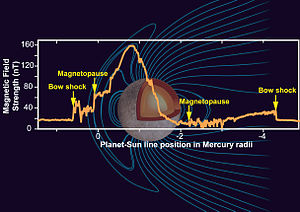
Back حقل عطارد المغناطيسي Arabic বুধের চৌম্বক ক্ষেত্র Bengali/Bangla Magnetické pole Merkuru Czech Champ magnétique de Mercure French Merkurovo magnetsko polje Croatian Magnetosfera di Mercurio Italian Магнетно поле на Меркур Macedonian Merkurs magnetfelt NB Магнітне поле Меркурія Ukrainian Từ trường Sao Thủy Vietnamese
 Graph showing relative strength of Mercury's magnetic field. | |
| Discovery[1] | |
|---|---|
| Discovered by | Mariner 10 |
| Discovery date | April 1974 |
| Internal field[2][3] | |
| Radius of Mercury | 2,439.7 ± 1.0 km |
| Magnetic moment | 2 to 6 × 1012 T•m3 |
| Equatorial field strength | 300 nT |
| Dipole tilt | 0.0°[4] |
| Solar wind parameters[5] | |
| Speed | 400 km/s |
| Magnetospheric parameters[6][7] | |
| Type | Intrinsic |
| Magnetopause distance | 1.4 RM |
| Magnetotail length | 10–100 RM |
| Main ions | Na+, O+, K+, Mg+, Ca+, S+, H2S+ |
| Plasma sources | Solar wind |
| Maximum particle energy | up to 50 keV |
| Aurora | |
Mercury's magnetic field is approximately a magnetic dipole (meaning the field has only two magnetic poles)[8] apparently global,[9] on planet Mercury.[10] Data from Mariner 10 led to its discovery in 1974; the spacecraft measured the field's strength as 1.1% that of Earth's magnetic field.[11] The origin of the magnetic field can be explained by dynamo theory.[12] The magnetic field is strong enough near the bow shock to slow the solar wind, which induces a magnetosphere.[13]
- ^ "MESSENGER Data from Mercury Orbit Confirms Theories, Offers Surprises". The Watchtowers. 2011-06-06. Archived from the original on 2013-02-04. Retrieved 2011-07-26.
- ^ Russell, C. T. (1992-12-03). "Magnetic Fields of the Terrestrial Planets" (PDF). UCLA – IGPP. Retrieved 2011-07-26.
- ^ Cite error: The named reference
Magnetic Field and Magnetospherewas invoked but never defined (see the help page). - ^ Williams, David, R. "Dr". Planetary Fact Sheets. NASA Goddard Space Flight Center. Archived from the original on 28 March 2014. Retrieved 6 September 2016.
{{cite web}}: CS1 maint: multiple names: authors list (link) - ^ James A. Slavin; Brian J. Anderson; Daniel N. Baker; Mehdi Benna; Scott A. Boardsen; George Gloeckler; Robert E. Gold; George C. Ho; Suzanne M. Imber; Haje Korth; Stamatios M. Krimigis; Ralph L. McNutt Jr.; Larry R. Nittler; Jim M. Raines; Menelaos Sarantos; David Schriver; Sean C. Solomon; Richard D. Starr; Pavel Trávníček; Thomas H. Zurbuchen. "MESSENGER Observations of Reconnection and Its Effects on Mercury's Magnetosphere" (PDF). University of Colorado. Retrieved 2011-07-27.
- ^ Reka Moldovan; Brian J. Anderson; Catherine L. Johnson; James A. Slavin; Haje Korth; Michael E. Purucker; Sean C. Solomon (2011). "Mercury's magnetopause and bow shock from MESSENGER observations" (PDF). EPSC – DPS. Retrieved 2011-07-26.
- ^ A. V. Lukyanov; S. Barabash; R. Lundin; P. C. Brandt (August 4, 2000). "Energetic neutral atom imaging of Mercury′s magnetosphere 2. Distribution of energetic charged particles in a compact magnetosphere – Abstract". Planetary and Space Science. 49 (14–15). Laurel, Maryland: Applied Physics Laboratory: 1677–1684. Bibcode:2001P&SS...49.1677L. doi:10.1016/S0032-0633(01)00106-4.
- ^ Tony Phillips (2008-07-03). "New Discoveries at Mercury". Science@Nasa. Retrieved 2011-07-16.
- ^ Williams, David R. "Planetary Fact Sheet". NASA Goddard Space Flight Center. Retrieved 2011-07-25.
- ^ Randy Russell (2009-05-29). "The Magnetic Poles of Mercury". Windows to the Universe. Retrieved 2011-07-16.
- ^ Jerry Coffey (2009-07-24). "Mercury Magnetic Field". Universe Today. Retrieved 2011-07-16.
- ^ Jon Cartwright (2007-05-04). "Molten core solves mystery of Mercury's magnetic field". Physics World. Retrieved 2011-07-16.
- ^ Randy Russell (2009-06-01). "Magnetosphere of Mercury". Windows to the Universe. Retrieved 2011-07-16.
© MMXXIII Rich X Search. We shall prevail. All rights reserved. Rich X Search